| Professional charting tools for .Net developers |
Introducing SharpPlot
Your First Chart
Recent Updates
Tutorials
General Tutorials
Chart Tutorials
Reference
SharpPlot Class
Properties
Methods
Structures
Enumerations
Style examples
Glossaries
Active Charts
VectorMath Class
DBUtil Class
Get SharpPlot
Download SharpPlot
Buying SharpPlot
SharpPlot Support
Upgrading from GraPL
Release notes
Home > Sample Charts > DialChart > Multiple Pointers and Zones
Multiple Pointers and Zones
The Dial or Gauge chart is often used to present a single value (maybe a benchmark index of company performance) in the context of an expected or desired range. The value on its own may mean very little (maybe our production plant made 23% rejects last week) until it is set in the context of the expected range.
The final chart has two values, which would typically by shown (as here) with pointers of different lengths. There is no limit to the number of pointers or Zones, but in practice this chart is probably at the limit of what the dial can reasonably display. It would be much better to make a matrix of dials using a trellis to show several related values.
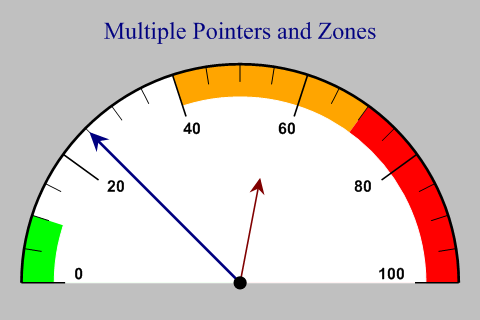
SharpPlot sp = new SharpPlot; sp.SetMargins(24,24,12,12); sp.Heading = "Multiple Pointers and Zones"; sp.SetBackground(Color.Silver); sp.SetChartBackground(Color.White,FillStyle.Solid); sp.SetAxisStyle(Color.Black,LineStyle.Solid,2); sp.SetXLabelFont("Arial",12,FontStyle.Bold); sp.SetColors(new Color[]{Color.Navy,Color.Maroon}); sp.DialChartStyle = DialChartStyles.ArrowLines; sp.SetPenWidths(new double[] {2,1.2}); sp.SetLineStyles(LineStyle.Solid); sp.SetXRange(100); sp.SetXTickMarks(20,3); xzones = new Zone[]{new Zone(0,10,Color.Lime),new Zone(40,70,Color.Orange), new Zone(70,100,Color.Red)}; sp.SetXZones(xzones); radii = new int[] {100,50}; data = new int[] {25,56}; sp.DrawDialChart(data,radii);
Worked Examples
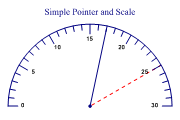 |
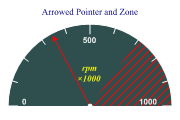 |
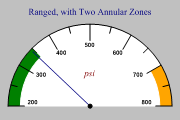 |
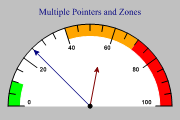 |